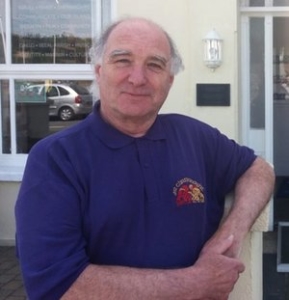Unfortunately, David Downie MBE was unable to come and talk about the hyperbaric chamber owing to illness. We all wish him a return to good health.
 In David Downie’s unfortunate absence, Bob Carswell gave an illustrated presentation about how mutual support amongst the Celtic countries continued to be a key component of Yn Chruinnaght, the annual Manx National and Inter-Celtic Festival, which celebrated 40 years since it was established by Mona Douglas in 1978. However, his talk was far broader than 40 years of Yn Chruinnaght, and aimed to show how the Eisteddfod movement in Wales had provided a source of inspiration for other Celtic countries, and had provided a hub at which many decisions had been taken over the years about inter-Celtic activity.
In David Downie’s unfortunate absence, Bob Carswell gave an illustrated presentation about how mutual support amongst the Celtic countries continued to be a key component of Yn Chruinnaght, the annual Manx National and Inter-Celtic Festival, which celebrated 40 years since it was established by Mona Douglas in 1978. However, his talk was far broader than 40 years of Yn Chruinnaght, and aimed to show how the Eisteddfod movement in Wales had provided a source of inspiration for other Celtic countries, and had provided a hub at which many decisions had been taken over the years about inter-Celtic activity.
Decisions concerning pan-Celtic ideas were made at meetings in and around the Eisteddfod. The foundation of the Celtic Congress came at the Eisteddfod in 1917. The Celtic League arose out of conversations involving Gwynfor Evans and Scottish and Breton delegates at the Eisteddfod in 1961. What was to develop into the Pan-Celtic Festival in 1972 came as a result of discussions at the Eisteddfod in 1971 – earlier in 1971, that had been an event involving Ireland, Wales and Brittany, but the following year grew to involve Cornwall, Scotland and Mannin.
An early proponent of pan-Celticism in Mannin was Sophia Morrison. Following her unexpected death in January 1917, she was succeeded as Secretary of the Manx Language Society and in her pan-Celtic correspondence by Mona Douglas, who was admitted as an Ovate of Gorsedd y Beirdd as Mona Manaw at the Eisteddfod in September 1917, and became Secretary of the Mannin Branch of the newly-founded Celtic Congress. In founding Yn Chruinnaght in 1978, Mona Douglas was delighted and proud that it was recognized by the Eisteddfod, and attended the Eisteddfod as a representative of Yn Chruinnaght – a link which Yn Chruinnaght seeks to perpetuate. She was made a Druid of Gorsedd y Beirdd in 1987, but was not well enough to attend the ceremony, dying a few months later. In celebrating 40 years of Yn Chruinnaght, there had been only nine whilst Mona Douglas was still with us, and thirty-one following her death – more than a generation, but her presence was still very much part of the festival.
Mona Douglas made very good use of the links she had forged through the Celtic Congress in developing Yn Chruinnaght. Yn Chruinnaght has also become part of a network of support with other Celtic national festivals such as Mod ny h-Alba and An tOireachtas, has been enriched by the spirit of co-operation it has had with the Pan-Celtic Festival, Festival Interceltique de Lorient, Lowender Peran, Speyfest, Cwlwm Celtaidd, and, of course, in Mannin itself with Shennaghys Jiu.
